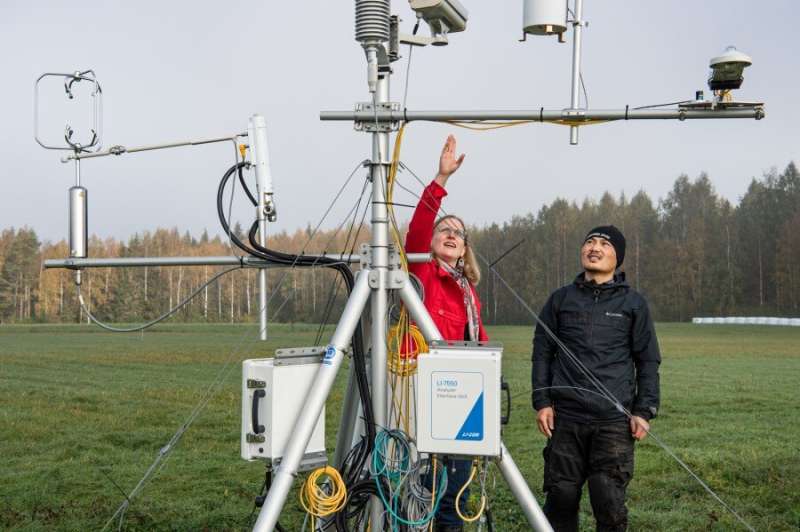A balance between agriculture and emissions can be found by managing the water table level of peat soils

In Finland, peat soils account for only ten percent of agricultural land; yet they are responsible for more than half of the country's agricultural emissions. At the moment, researchers are working hard to find smart agricultural techniques for climate and food production, so that peat soils could continue to be used in food production. The proportion of peat soils used as agricultural land varies from one region to the next. In some places, they are important areas of food production.
"Agricultural practices are one factor in the equation that can influence greenhouse gas emissions," Researcher Saara Lind from the Natural Resources Institute Finland says.
"Peat soils have a lot of organic material left in them. When the soil is drained, peat decomposes at an accelerated rate, which causes greenhouse gas emissions, such as carbon dioxide and nitrous oxide, into the atmosphere. We are trying to find a balance between growing food and still mitigating emissions by managing the water table level."
Farmers need accurate information on optimal water table levels. For this purpose, an experimental site has been set up in a peat soil in northern Savo. The Maaninka Särkisuo site is one the new research areas of the Natural Resources Institute Finland, and it is used as an experimental setting in the ORMINURMI project.
"This field is used for the cultivation of forage. This year, the field was established in a cover crop of oats and wheat, and we are growing a grass mixture of timothy and meadow fescue. There is also a strong natural seed bank in the field, so we can see also other species here. The field is drained peatland, and we are now using subsurface drains to manage the water table level," Lind explains.
The Natural Resources Institute Finland is responsible for the cultivation of the field, and the University of Eastern Finland is involved in the measurement of greenhouse gases, among other things. The study also examines biomass, the development of root systems, and forage yields.
Doctoral Researcher Zheng Yu from the Department of Environmental and Biological Sciences at the University of Eastern Finland is carrying out measurements for his Ph.D. thesis at the Särkisuo site, under a grant awarded by Nessling Foundation. Greenhouse gas emissions are measured both on site in the field, in response to water table fluctuations under natural conditions, and in mesocosm experiments controlling the water table, where greenhouse gas emissions are measured by studying soil samples.
"The aim is to combine data from all the measurements and conclude the optimal water table levels in relation to both greenhouse gas emissions and yields," Zheng Yu explains.
"High water table levels are the best way to slow down the decomposition of peat, thereby reducing carbon dioxide and nitrous oxide emissions."
"In my doctoral research, I will also examine the effects of different water table levels on nitrous acid and nitric oxide emissions, which also have a significant impact on the climate and air quality," he says.
Zheng Yu's field experiment involves, firstly, a metal chamber, a box without a bottom, which is placed on the field. During one measurement session, four different gas samples are taken from inside the chamber. The samples' gas concentrations, including methane, nitrous oxide and soil and plant respiratory carbon dioxide, are then analyzed in the laboratory using a gas chromatograph.
The other in-situ measurement monitors the exchange of carbon dioxide. The chamber is transparent, and the plants get a normal amount of light, which means that carbon dioxide levels inside the chamber decrease due to photosynthesis. This will be followed by a measurement under dark conditions, where photosynthesis is prevented. The carbon dioxide concentration is determined every other second for a duration of two minutes.
"The plants may not sequestrate carbon dioxide today, because clouds are casting a shadow, and that has an impact on how much effective light they get," the researchers say.
"The results indicate the net exchange of carbon dioxide. Modeling is used to determine carbon dioxide sequestration rates under different light conditions."
Greenhouse gases are also measured in the field using an automatic, continuous eddy covariance technique. This experiment determines the concentrations of greenhouse gases carried by the wind, as well as wind direction and wind speed. These give information about the direction and the speed at which gases are moving. Based on this data, it is possible to calculate greenhouse gas fluxes.
"Research into the carbon dioxide emissions released by peat soils is a broad entity, and our understanding of it is still incomplete. The development of measurement methods and modeling constantly gives us new insight into how peat soils can be used. There is still hope of a better future for the climate, but action is needed now."
"It's not too late yet," the researchers say, reassuringly.
Provided by University of Eastern Finland




















